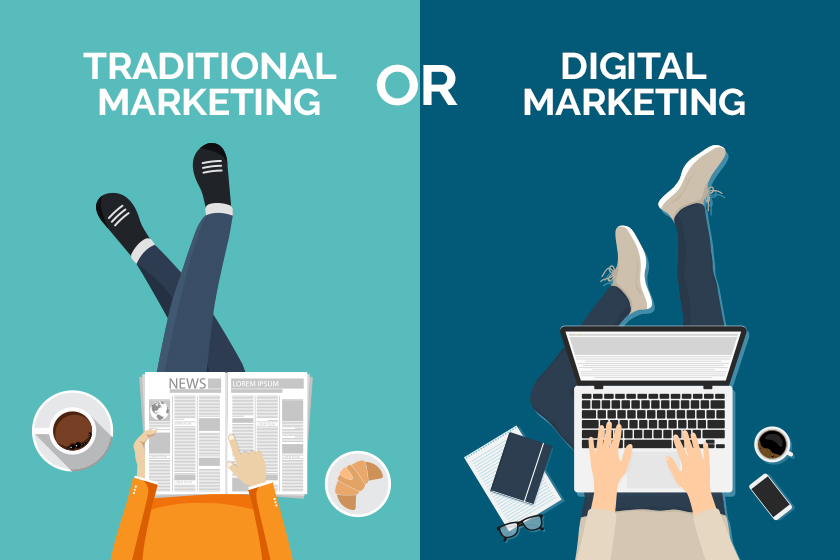It is the age-old debate, traditional marketing or digital marketing, what is more influential to engage your audience? Whilst digital marketing is a more new-age online focused approach to targeting your audience and gaining sales, traditional marketing techniques are the benchmark of gaining a reputation and raising awareness.
Below the main ideologies of both marketing techniques will be itemized and explained for you to make your decision on which one reigns supreme.
Traditional Marketing

Traditional marketing sounds outdated, but in fact it is the backbone of society’s ability to absorb marketing information released by big firms. The main channels traditional marketing operate through are below:
- Outdoor (Billboards, bus/taxi wraps, posters etc)
- Broadcasting (TV, Radio etc)
- Print (Magazines, newspapers etc)
- Direct Mail (catalogues etc)
- Telemarketing (Phone, text message)
- Window display and signs.
It is considered to be a more mass marketing approach, meaning the channels used to get certain marketing messages across are not niche to the specific different target audience.
Nevertheless, these are beneficial for larger brands and companies that are not offering specified products or services. The negative connotations of traditional marketing are not justified, they work wonders for most that adopt them.
There are also a lot of websites and outsourcing companies that can help you develop stellar traditional marketing accoutrements, for example https://www.printmoz.com offer amazing print focused traditional marketing additions that can be handed out or showcased to your clientele.
Pros of Traditional Marketing

Traditional marketing is more memorable, they rely on a jingle, storyline, character to help the audience remember and associate said things with their brand. A great example of this would be the Cadbury’s chocolate, they used innovative music and character plots in their TV advertisements that spiked huge debates and social discussion, or word of mouth marketing.
It is also a more permanent way of getting your brand noticed and remembered forever. Because it uses physical form to promote the company or business these can be considered keepsakes or references points for said company forever.
They usually become a benchmark in the company’s rise to fame and are always associated with that company. This you could argue makes them more impactful and recognized as opposed to digital marketing. Also this way your physical presence means more interaction with potential buyers.
Cons of Traditional Marketing
Traditional marketing is synonymous with mass marketing, meaning it does not directly engage with the audience, where digital marketing can be specified from customer to customer. Due to its mass marketing focus it can be expensive to roll out, as TV and billboard advertisements are notoriously costly.
Due to the usage of traditional marketing being a preferred choice of marketing for larger, more developed brands and companies, its true impact is hard to really know. This is because they have already made a name for themselves and are just re-evoking a response.
Digital Marketing

With the rise of Web 2.0 saw the increase in online marketing and its increased potential. Digital marketing took the world by storm and has continued to get more and more influential to all businesses, small and large. It is as cheap or expensive as your budget allows and there are so many variations of digital marketing that you can adapt to best suit your businesses wants and needs. The main digital marketing channels are:
- Social media (Facebook, Instagram etc.)
- Website
- Content marketing
- Affiliate marketing
- Inbound marketing
- Email marketing
- PPC (pay per click)
- SEM (Search engine marketing)
Digital marketing has been dubbed as the pinnacle of marketing’s true abilities. It is able to pinpoint and target the desired audience of the company, if it’s measurable and much more affordable.
It has opened up the marketing spectrum to such a diverse set of companies and really impacted niche audiences and brands into becoming very well known overnight. Its focused approach allows customers to feel special, as if the advertisement is solely for them.
Pros of Digital Marketing

Due to its digital nature it’s measurable, targeted and engagement can be increased, edited and responded to almost immediately. This gives brands the power of speaking directly to their clients and offering a more personalized marketing experience, which could lead to more sales and a better representation of their brand.
It also has a global reach, meaning your company can diversify its locational scope, expanding and earning more sales in remote or otherwise inaccessible countries and territories too.
Cons of Digital Marketing
The digital world is always evolving, so there is high maintenance costs to keep up to date and it can be very time consuming. It relies solely on technology, so if there is an issue with the software, site or social media platform your market from it can hinder your company’s image.
There are some major privacy issues with regards to re-marketing and tracking customers online, most audiences really do have big issues with this and it is an infringement on their personal privacy.
Conclusion
Whilst there are massive benefits with both traditional and digital marketing strategies, they really work best when implemented together. This is of course budget dependent, but incorporating aspects of both forms of marketing will ensure that no demographic is missed and that you are able to see which one is more beneficial for you, and then focus on that rather than missing out by choosing one over the other.









